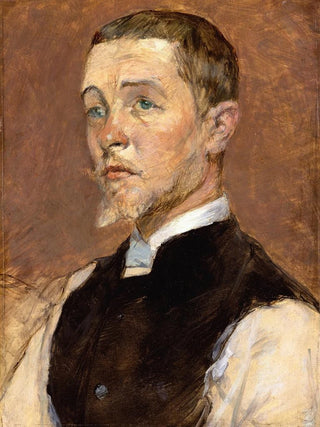Art print | Albert René Grenier 1858-1925 - Henri de Toulouse-Lautrec


View from behind

Frame (optional)
Albert René Grenier 1858-1925 - Henri de Toulouse-Lautrec – Engaging Introduction
The artwork "Albert René Grenier 1858-1925 - Henri de Toulouse-Lautrec" is part of an artistic period where the post-impressionist movement gained significant momentum. Through this art print, the viewer is transported into the vibrant and often tumultuous universe of La Belle Époque, where the artist captured the very essence of Parisian life. Toulouse-Lautrec, with his sharp eye and unique sensitivity, immerses us in a world where joy and melancholy coexist, where each brushstroke tells a story. This piece, both a homage and a reflection, invites deep contemplation, revealing the nuances of a lively era.
Style and uniqueness of the work
Toulouse-Lautrec's style is distinguished by his ability to blend reality and expression. His technique, characterized by bold lines and vibrant colors, brings his characters to life, whether they originate from cabarets, theaters, or Parisian salons. In "Albert René Grenier 1858-1925," the artist employs a rich palette, where warm hues are contrasted with delicate shadows, creating a play of light that emphasizes the emotions of the depicted figures. Every detail, every gesture is meticulously crafted, demonstrating a concern for authenticity and an ever-evolving aesthetic pursuit. This art print does not merely depict a subject; it interprets, transcends it, offering the viewer an immersive, almost cinematic experience.
The artist and his influence
Henri de Toulouse-Lautrec, born in 1864, is one of the most emblematic artists of the late 19th century. Coming from an aristocratic family, he broke free from conventions to embrace the world of artists of his time. His work is marked by profound humanity, empathy for the models he portrays, often marginalized figures of society. Toulouse-Lautrec had a considerable influence on the development of modern poster art, transforming the way art could be used to communicate ideas and emotions. His innovative approach paved the way for

Matte finish

View from behind

Frame (optional)
Albert René Grenier 1858-1925 - Henri de Toulouse-Lautrec – Engaging Introduction
The artwork "Albert René Grenier 1858-1925 - Henri de Toulouse-Lautrec" is part of an artistic period where the post-impressionist movement gained significant momentum. Through this art print, the viewer is transported into the vibrant and often tumultuous universe of La Belle Époque, where the artist captured the very essence of Parisian life. Toulouse-Lautrec, with his sharp eye and unique sensitivity, immerses us in a world where joy and melancholy coexist, where each brushstroke tells a story. This piece, both a homage and a reflection, invites deep contemplation, revealing the nuances of a lively era.
Style and uniqueness of the work
Toulouse-Lautrec's style is distinguished by his ability to blend reality and expression. His technique, characterized by bold lines and vibrant colors, brings his characters to life, whether they originate from cabarets, theaters, or Parisian salons. In "Albert René Grenier 1858-1925," the artist employs a rich palette, where warm hues are contrasted with delicate shadows, creating a play of light that emphasizes the emotions of the depicted figures. Every detail, every gesture is meticulously crafted, demonstrating a concern for authenticity and an ever-evolving aesthetic pursuit. This art print does not merely depict a subject; it interprets, transcends it, offering the viewer an immersive, almost cinematic experience.
The artist and his influence
Henri de Toulouse-Lautrec, born in 1864, is one of the most emblematic artists of the late 19th century. Coming from an aristocratic family, he broke free from conventions to embrace the world of artists of his time. His work is marked by profound humanity, empathy for the models he portrays, often marginalized figures of society. Toulouse-Lautrec had a considerable influence on the development of modern poster art, transforming the way art could be used to communicate ideas and emotions. His innovative approach paved the way for






